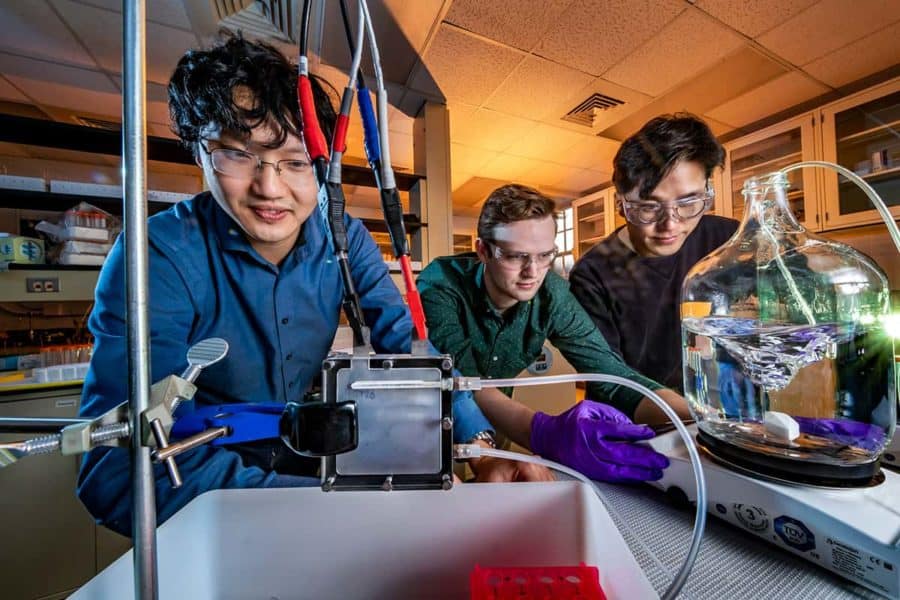It takes a lot of energy to collect, clean and dispose of contaminated water. Some contaminants, like arsenic, occur in low concentrations, calling for even more energy-intensive selective removal processes.
In a new paper, researchers address this water-energy relationship by introducing a device that can purify and remediate arsenic-contaminated water in a single step. Using specialized polymer electrodes, the device can reduce arsenic in water by over 90% while using roughly 10 times less energy than other methods.
The findings of the new study are published in the journal Advanced Materials.
Arsenic is a naturally occurring element that enters aquifers, streams and lakes when water reacts with arsenic-containing rocks and is considered highly toxic, the researchers said. This is a global issue affecting more than 200 million people in 70 countries.
Not all arsenic is the same, said Xiao Su, a chemical and biomolecular engineering professor at the University of Illinois who directed the study. The most dangerous form of arsenic, known as arsenite, is highly reactive with biological tissues, but converts to a less toxic form, called arsenate, through a simple oxidation reaction.
“We can remove arsenite from water using absorbents, specialized membranes or evaporation, but these are all very energy-intensive processes that ultimately leave behind a lot of toxic waste,” Su said. “By having a device that can capture arsenite with a high selectivity and convert it to a less toxic form, we can reduce the toxicity of the waste while purifying the water.”
The proof-of-concept device works by integrating the contaminant separation and reaction steps within a single unit with an electrocatalytic cell – similar to a battery –using redox-active polymers. When the contaminated water enters the device, the first polymer electrode selectively captures the arsenite and sends it to the other polymer electrode, where it is stripped of two of its electrons – or oxidized – to form arsenate. Pure water then leaves the device, and the arsenate waste is concentrated for further disposal, Su said.
“The process is powered by electrochemical reactions, so the device does not require a lot of electricity to run and allows for the reuse of the electrodes based only on electrochemical potential,” Su said. “Combining the separation and reaction steps into one device is an example of what we call processes intensification, which we believe is an important approach for addressing environmental concerns related to energy and water – in particular, the amount of energy it takes to purify and remediate contaminated water.”
In addition to improved sustainability and energy efficiency, this elctrochemical approach has advantages for field deployment, the researchers said. Users can run the device using solar panels in areas where electricity is scarce – like in parts of rural Bangladesh, a country where over 60% of the population is affected by arsenic-contaminated water, the researchers said.
There are challenges to address before the device is ready for real-world implementation. “We need to increase the stability of the electrodes because this process will need to be cycled many times while running,” Su said. “We’re using very specialized, highly advanced polymer materials for the electrodes. However, we need to make sure we design them to be not only highly selective for arsenic, but also very stable and robust so that they do not need to be replaced constantly. This will require further chemical development to overcome.”
Su also is affliated with the Beckman Institute for Advanced Science and Technology at the U. of. I.
Postdoctoral researcher Kwiyong Kim and graduate student Stephen Cotty, both from the Su group, are the lead authors of the study. Professor Chia-Hung Hou, from the Graduate Institute of Environmental Engineering at the National University of Taiwan, collborated with the U. of I. on this research.
The National Science Foundation and the U. of I. supported this research.
To reach Xiao Su, call 217-300-0134; email [email protected].
The paper “Asymmetric redox-polymer interfaces for electrochemical reactive separations: Synergistic capture and conversion of arsenic” is available online and from the U. of I. News Bureau. DOI: 10.1002/adma.201906877


